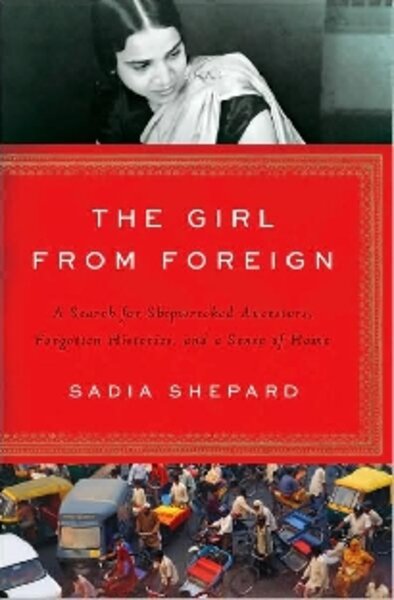The Girl From Foreign
Loading...
When the author of this exquisite memoir arrives in India to begin her year as a Fulbright Scholar at the Film and TV Institute of India, an officious guard refuses her entrance. Her name is “not on the list.” She persists, showing her official documents and trying to talk her way in. Though her mother is of Indian and Pakistani descent, and she bears a Muslim name – Sadia – she doesn’t exactly blend in.
“I know how alien I look,” she writes. “I am paler and taller than everyone else. And in my outdated salwar kameez [pants and tunic], I can be pegged as an outsider right away.” Finally, the guard realizes she may belong there, if simply because she doesn’t belong anywhere else. We can imagine his clipped Indian English as he says, “You are from Foreign?”
This moniker will stick as she begins the search for her family’s Jewish roots in The Girl from Foreign: A Search for Shipwrecked Ancestors, Forgotten Histories, and a Sense of Home by Sadia Shepard. The memoir is a gorgeous, honest tribute to her departed maternal grandmother, Nana, whose unlikely history propels the search. Part love story, part history, part search – not only for what was lost, but for how to understand what is found – the tale also traces paths not taken by Nana.
The stories are compelling, the writing is clear, and the entire book feels like an act of love and courage. As documentary filmmaker and photographer, Shepard knows how to move through scenes, pack them with dialogue, focus on key details, and capture the juxtaposition of opposites that will fascinate us outsiders.
The quest starts back when the author, at age 13, discovers a pin bearing the name “Rachel Jacobs” in her Muslim grandmother’s jewelry box in their home outside Boston. Nana explains that she grew up in India in a Jewish family, part of the Bene Israel (Children of Israel) community, thought to be one of the lost tribes that fled Israel two thousand years ago and landed, shipwrecked, on the shores of India.
They lost their Torahs, Nana says, but they remembered one prayer, and continued to pray to one God. “So are you Muslim or are you Jewish?” young Sadia asks.
“Now I’m a Muslim, but God is the same in both religions,” Nana replies.
Later, Nana will answer that question differently: “I don’t know. One is the religion of my forefathers, and the other is the religion of my children.”
Sadia learns about her Nana’s secret marriage to an older Muslim man, and about her eventual move to Pakistan into the family compound with her husband’s two other wives and countless children. It is to this house, too, that the author will return, and where one of Nana’s old keys will unlock a drawer and reveal romantic secrets.
Like her granddaughter, she, too, lived as a “girl from Foreign,” as a Jew in Hindu India, then as an Indian Jew in Muslim Pakistan, and finally as an Indian Muslim in the United States.
As the author traces Nana’s steps, she paints a rich portrait of today’s India – the sights, smells, and sounds of bustling Bombay, as well as the verdant and tranquil countryside, where Jewish relatives, seed-pressers, still eke out a living hand-crushing seeds to make oil.
Shepard takes us to Pakistan for a family wedding, where the jet doors open to “those heady scents of arrival: jasmine flowers, gasoline, burning trash, and cow dung.”
She has a filmmaker’s eye for detail. When she arrives unannounced to start Hindu lessons, the teacher’s wife answers the door, snatches the clean shirt hanging on the clothesline, and in a few minutes ushers Shepard in to meet the teacher who is wearing – of course – that clean shirt. This is life in the developing world, where belongings are few and precious.
This book will leave readers wanting more. Thankfully there are a couple dozen photographs – some vintage, but most taken by the author herself. Why should memoir be limited to the written word?
We look forward to more from this talented writer, photographer, and filmmaker. In the meantime, the questions she has raised linger: What does it mean to be Jewish, Muslim, Indian, Christian? Are they simply labels, chosen by the wearer? Are they exclusive, or can they be tried on, borrowed from, combined?
Readers will find themselves wondering about their own heritage as they read this enchanting tale of family, memory, loyalty, and love.
Elizabeth Brown is a freelance writer living near Hillsborough, N.C.






